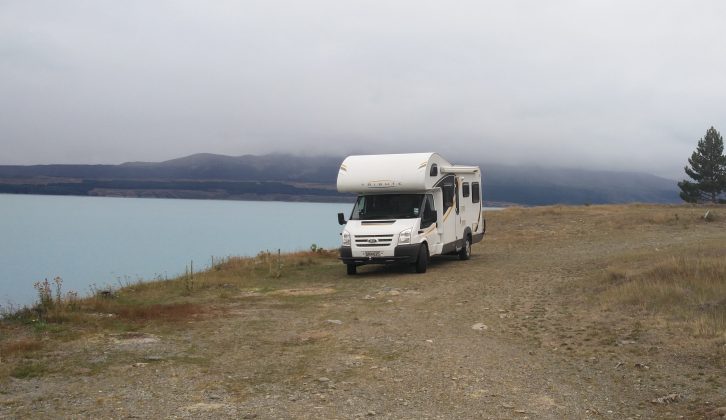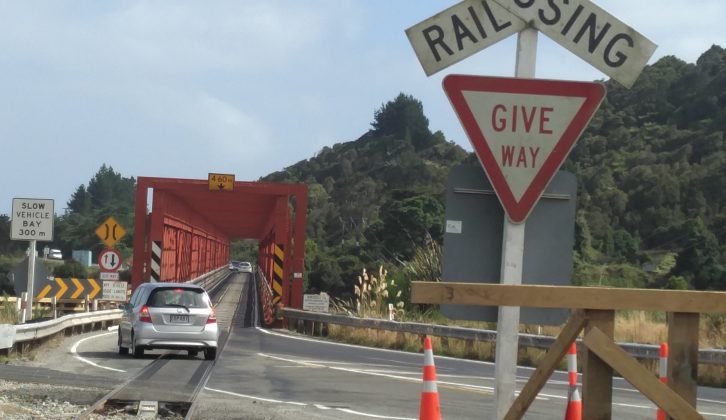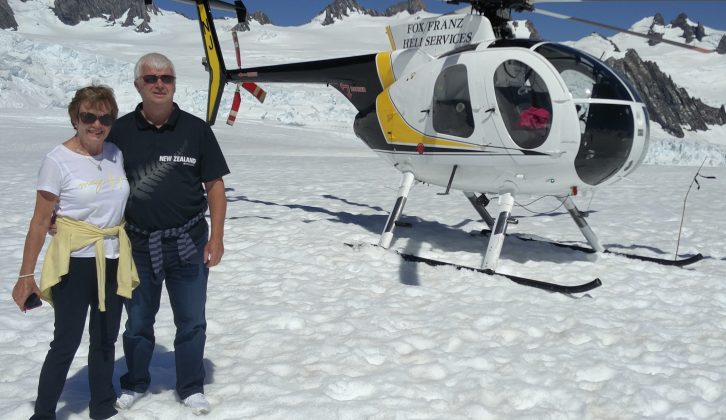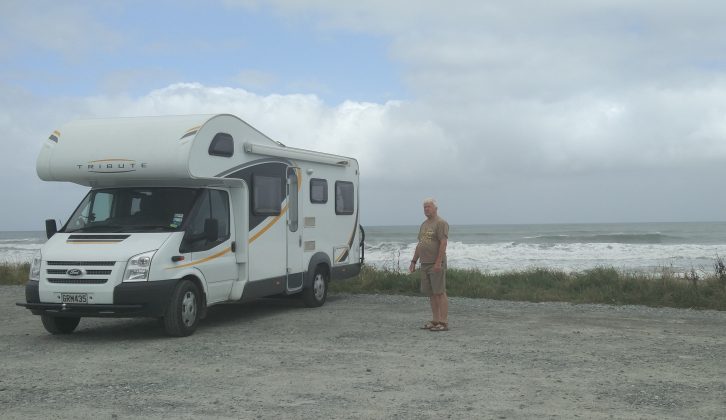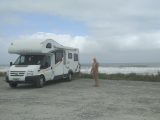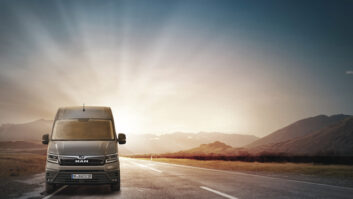I was interested to read Gary Blake’s grand tour of New Zealand in the February and March 2016 issues of Practical Motorhome. My wife and I did a similar trip in 2005 when we first visited our younger son, Ian, who’d emigrated to Wellington two years earlier. Our older son, Paul, decided to take a gap-year world trip, so he accompanied us with the intention of staying on after we came home.
On that occasion, we flew to Christchurch where Ian met us. He drove his car there via the Wellington-Picton ferry. We rented a four-berth campervan from the airport and spent the first night in Christchurch to get over the jet lag, before embarking on a similar route to that taken by Gary around the South Island, travelling in convoy.
When we reached Queenstown, Paul bought a secondhand van that had a mattress in the back to turn it into a very crude campervan. We spent about two weeks on the South Island, then took the ferry to Wellington and drove across the North Island to Auckland, from where we flew back home. Paul stayed on in New Zealand for about four months (living in his ’van), after which he moved on to Sydney, en route for home. He got a job to replenish his funds, and has been there ever since!
Since then, we’ve made numerous trips Down Under to visit both of our boys, usually including some time in a campervan. For our next trip, we flew to Melbourne where we hired a motorhome and took a leisurely two-week drive to Sydney, then stayed a further week with Paul. The following year we flew to Auckland in New Zealand, where we spent a week with Ian before flying to Cairns in Australia, to meet up Paul and visit the Great Barrier Reef. We then flew to Brisbane where we hired a ’van to drive to Sydney. Last year we spent three weeks with Paul, then hired a campervan which we took for a few days to the BIG4 Easts Beach Holiday Park in Kiama, south of Sydney, then to the Bonnie Vale National Park campsite.
Now that we are retired, we can stay longer. But our real concern is the cost of accommodation and transport. However, we’ve now hit on a good solution for this.
Another way
We have a Hymer B564 A-class motorhome, so we thought of trying to arrange a swap with a motorhome owner in New Zealand and/or Australia. We registered with RV Worldwide and through it we made contact with Glen and Shirley Brickell in Queenstown, New Zealand. We wanted to go there for three weeks in January/February, and Glen and Shirley wanted to tour the UK for four weeks in June/July. We could all see the benefits, but it is obviously a big decision to allow a stranger exclusive use of your treasured motorhome. We therefore exchanged numerous emails, so we got to know each other – we all needed to feel certain that our beloved ’vans were in safe hands and would be treated well.
Shirley met us at Queenstown airport and drove us to their home, where she and husband Glen showed us around their Ford-based Tribute motorhome, and introduced us to their family. They told us of the places they’d visited and said that they usually used Freedom Camping, rather than staying in commercial campsites. Freedom Camping is widely accepted in New Zealand, and there is a general rule that it is allowed in most places outside residential areas. We’d already heard of this, and I’d downloaded a very useful app on my phone called Camping NZ, which lists hundreds of motorhome camping locations (including both commercial sites and Freedom Camping sites), with photographs and user reviews.
The following day, we headed north through Wanaka to Lake Pukaki, where we stopped for the first night at the waterside. We next moved on to Christchurch, where we were stunned to see the extent of the damage caused by the 2011 earthquake. Most of the shopping centre was destroyed, but they have ingeniously created a temporary shopping precinct using shipping containers. Extensive re-building work is in progress but the cathedral, which was extensively damaged, is still a ruin.
On a happier note, our next stop was Kaikoura, which is a well-known location for whale watching. We took a helicopter ride, from which we saw many pilot whales and dolphins, but the hoped-for sperm whales didn’t surface.
Enjoying the freedom of motorcaravanning
Using the Camping NZ app, we found an amazing Freedom Camping site a few miles north at Hapuku. It was a cul-de-sac lane running parallel to the coastline, with numerous pull-ins overlooking the beach. The inland backdrop was a beautiful mountain range, which looked stunning in the morning when seen through low cloud. These are the beautiful moments when motorcaravanning really comes into its own, when you’re reminded that travelling like this allows you to see and experience things you’d not otherwise be able to.
We spent a total of five days driving from Queenstown to Picton (at the northern end of the South Island), from where we took the ferry to Wellington (which is at the southern end of the North Island) to meet our son Ian. And, again, we found a good Freedom Camping site through the Camping NZ app. In Wellington, this site was at the southern end of the Evans Bay Marina car park, which is council-owned and right on the waterfront. The rules state that the maximum stay is four nights in any month which was very convenient for us, as our stay extended over January and February. It’s free, close to the city, and has a water supply, toilets and waste water disposal. We were thus able to use it as a base to spend over a week with Ian – perfect.
We decided to return to Queenstown via the west coast of the Southern Island, which is less populated and has some amazing scenery. The roads are very good, but there is little traffic – we can’t recommend it enough. Many of the bridges are single-track, but the most fascinating was the one we crossed that was shared with a railway line!
Touring in January and February, we enjoyed typical, summertime New Zealand weather, with temperatures typically in the high 20s. Intriguingly, however, there are two glaciers midway down the South Island and we couldn’t resist taking a helicopter ride to view them. It was very strange to be standing on deep snow dressed in t-shirts, but the views were absolutely astounding.
We returned the motorhome to Glen and Shirley after three memorable weeks. They were, again, extremely hospitable and drove us back to the airport, leaving us with many fond memories. We can’t wait for them to visit us in the UK so we can reciprocate and loan them our motorhome. We only hope they enjoy their trip as much as we enjoyed ours.
Doing it right
We can thoroughly recommend the idea of swapping motorhomes. It allows you to live like a local wherever you’re touring, enjoying a true home-from-home, even when you’re thousands of miles away from home. It obviously works best with the southern hemisphere where the seasons are reversed, but RV Worldwide’s website covers the whole world.
Swapping obviously need to be treated with a certain degree of caution, as it is totally dependent on the goodwill of both parties. Before committing you must develop a good relationship so you can trust each other. The website gives some advice, such as checking the owner’s address through Google Maps and Google Streetview. We are still receiving requests from other users for swaps, but we can only manage one a year, so hopefully we will organise something similar in 2017.
Insurance can be an issue. There is no problem in New Zealand, but British insurance companies are not so easy. My motorhome policy would only cover drivers who have held a UK driving licence for at least three years and/or have been resident in the UK for at least two years. This is a common requirement of most insurers. I had to do considerable shopping around before coming up with a solution. Both Comfort Insurance and NFU Mutual are able to cover temporary overseas drivers for up to four weeks, at a cost of around £55 per week.
Incidentally, some people may be concerned about the flight time when travelling to Australia or New Zealand. The total flying time will be nearly 24 hours, but the in-flight entertainment is very good with dozens of films, videos and music to help pass the time. In between, we try to sleep as much as possible. You will inevitably have a stop-over on the way, and you can decide whether to arrange flights with the minimum delay or to stay over for a day or two. We have tried both options and our preference is the minimum delay, because we feel that the objective is to get to the destination as soon as possible.
Jet lag can be a problem, but we have never suffered unduly on the way out, partly because, as stated earlier, we try to sleep as much as possible on the plane. I guess the excitement and anticipation of the forthcoming holiday keeps you going, too. The return flight is another matter, maybe in part because it is an anti-climax. We always sleep solidly for a couple of days when we get back! That’s fine if, like us, you’re retired, but if you’re booking days off work, it might be something additional to bear in mind.
So if you love motorcaravanning and you fancy a fly-drive adventure that offers more of a personal touch than you’ll get if you use a conventional motorhome hire company, perhaps ’van swapping is for you, too!
It needs to be treated with a certain degree of caution, as it is totally dependent on the goodwill of both parties
